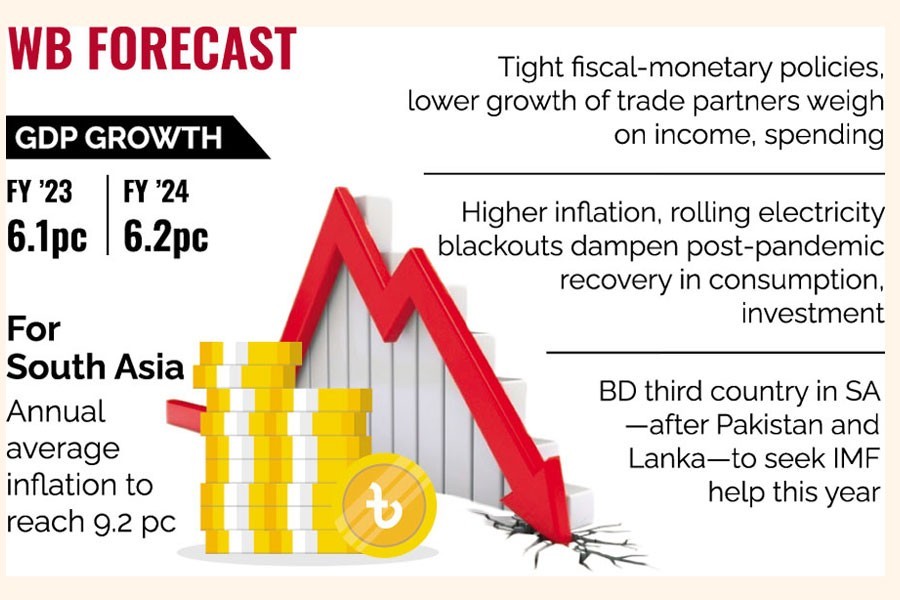Bangladesh may see slower economic growth at 6.1 per cent in the current fiscal year, the World Bank says in a downbeat update citing umpteen adversities inside and abroad.
The latest forecast growth rate is 0.6-percentage-point down from its June projection. In June last, the World Bank projected Bangladesh's gross domestic product (GDP) to grow by 6.7 per cent.
Tight fiscal and monetary policies and lower growth of trading partners outside the region will weigh on income and spending, the WB says about a cardinal cause in its report released Thursday.
The global development financier, however, projects a slightly higher GDP growth at 6.2 per cent for the next FY2024.
The World Bank released its 'South Asia Economic Focus, Coping with Shocks: Migration and the Road to Resilience' report Thursday from its headquarters in Washington. WB Chief Economist for South Asia Hans Timmer briefed on the report while Vice President for South Asia Martin Raiser also spoke.
Enumerating the decelerators it says: "In Bangladesh, GDP growth is projected to decelerate slightly to 6.1 percent in FY2022-23, as higher inflation and rolling electricity blackouts dampen the post-COVID recovery in consumption and investment.
"The lack of reliable high-frequency indicators creates difficulties for policymakers to track economic development. Higher inflation is expected to dampen private consumption growth, following substantial energy-price increases."
It forecasts that export growth is expected to slow, as economic conditions in key export markets deteriorate, while rolling blackouts, gas rationing, and rising input costs weigh on manufacturing output.
Hans Timmer said the current-account balance in the South Asian (SA) region will improve slightly during the second half of 2022 as imports fall faster than exports and remittances continue to recover.
About export, the WB Chief Economist said in the short term, slowing external demand growth especially in the US and EU markets would be reflected in slower growth of manufacturing exports, particularly textile and garment exports for Bangladesh, Pakistan, and Sri Lanka.
On the inflationary pressure on stream, the WB report says the inflation in South Asia is expected to rise in 2022 and decline thereafter, as many of the sources of inflationary pressure gradually subside.
"Annual average inflation will reach 9.2 per cent in 2022 as Sri Lanka's inflation soars to over 45 per cent and Pakistan's price pressures worsen amid scarcity compounded by the floods. This is the highest level since 2009-when inflation reached 11.2 per cent, largely because of currency depreciations during the global financial crisis-and the second-highest level this century."
By 2023 and 2024, inflation is expected to moderate almost everywhere as commodity prices stabilize and "hawkish monetary policy" is fully implemented.
"Though inflation in Bangladesh is forecast to remain at single-digits, it is at the cost of stifling a market response. Much of the price suppression comes from a plethora of quantity restrictions, including fuel subsidies and artificial inhibition of the domestic credit market through interest- rate controls," the Bank says.
Per-capita GDP in the region is expected to grow about one-percentage-point lower than earlier expected by 2023. "Though Bangladesh's per-capita GDP is set to continue growing, it has lost momentum as institutional challenges impact growth-promoting policies. The forecast reflects still high export growth but insufficient diversification of earnings."
The World Bank has painted a gloomy picture on poverty alleviation in the SA region, saying it will not fall as quickly as earlier expected, as inflation, recent weather-related agricultural losses and rationing of fuel and other products are expected to hit South Asian poor the hardest.
Mr Timmer said: "Major manufacturing exporters Pakistan and Bangladesh see a negative but relatively smaller effect than their large neighbors do, in part because their main exports to high-income countries, textiles and garments, tend to be less sensitive to high-income GDP growth."
Indeed, Bangladesh's basic garment exports soared during the 2007-08 financial crisis as US and EU consumers switched to lower-cost clothing, the WB noted.
Turning to remittance, the WB report says remittance-dependent households in Nepal and Bangladesh experienced a disproportionate drop in earnings driven by a drop in remittances.
"In Bangladesh, the pressures on the public finances are expected to continue. The decline in government investment will not be enough to offset increasing subsidy and incentive expenditure. The fiscal deficit is projected to increase slightly from 4.1 per cent of GDP in FY22 to 4.9 per cent in FY2023," the WB report says.
Amid increasing balance-of-payments pressure and falling foreign-exchange reserves, Bangladesh requested financial support from the IMF in July, making it the third country in the region-after Pakistan and Sri Lanka-to be engaging with the IMF this year, it noted.
"But unlike the other two countries, Bangladesh's reserves have not fallen to dangerously low levels, the country is not facing political instability, and inflation is still below 10 percent although it is above recent historical levels."
In Bangladesh, the government recently deferred lower-priority development projects that require significant imports to ease balance-of-payments pressure.
On the SA economy, the WB report forecasts that this region's GDP may expand at an average of 5.8 per cent rate this year - a downward revision of 1.0 percentage points from the forecast made in June.


